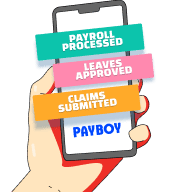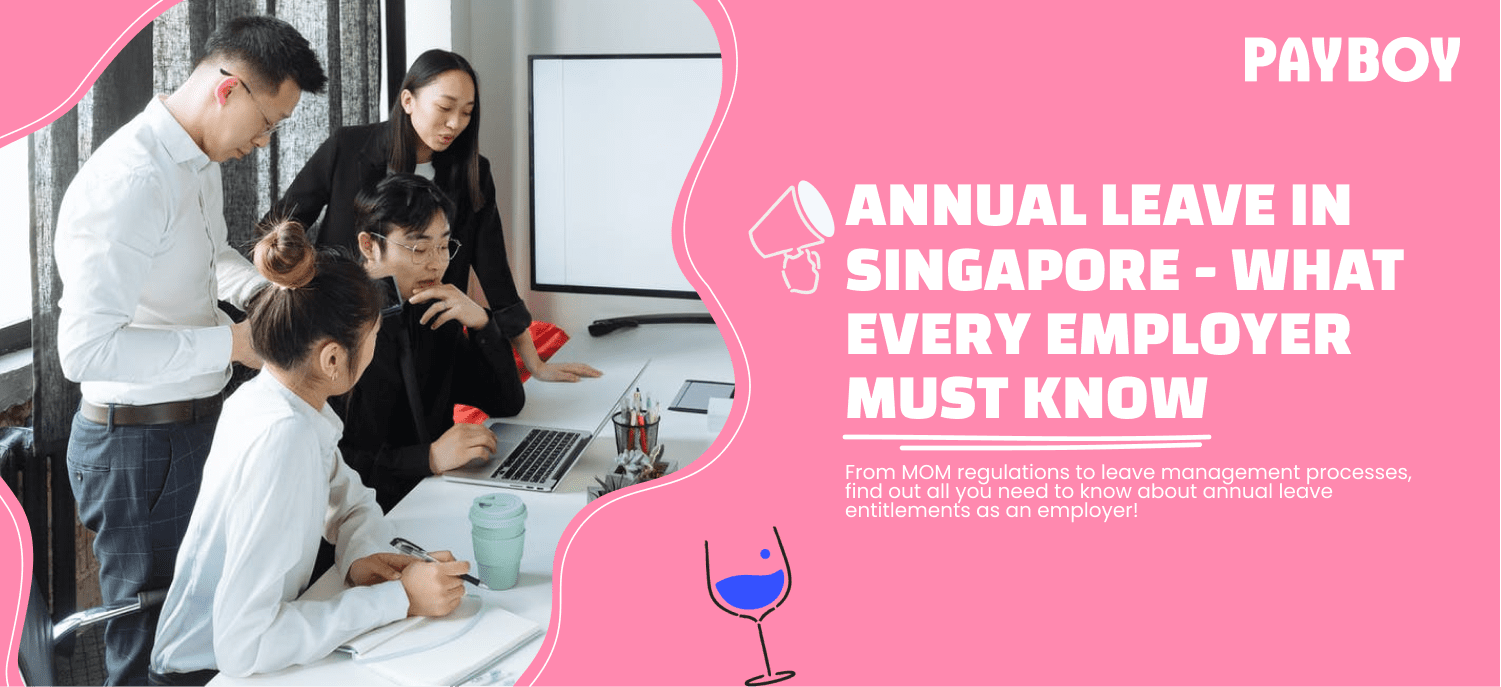As an employer, managing annual leave well is an important part of ensuring that your employees are happy and productive. In this article, we'll provide an overview of annual leave entitlements in Singapore, as well as some useful tips on managing annual leave. So read on and find out everything you need to know about annual leave in Singapore!
Annual leave entitlement
What is the annual leave entitlement recommended by MOM?
To qualify for annual leave, the employee must work for the employer for at least 3 months and can only apply for annual leave after working for 3 months.
The minimum number of paid annual leave is 7 days during the first year of employment, and 1 extra day for each additional year of service up to a maximum of 14 days.
Edit
| Year(s) of employment |
Minimum no of paid annual leave entitlement |
| 1 |
7 |
| 2 |
8 |
| 3 |
9 |
| 4 |
10 |
| 5 |
11 |
| 6 |
12 |
| 7 |
13 |
| 8 and above |
14 |
Employers may of course provide more annual leaves than the minimum requirement as part of their employees benefits.
How to calculate pro-rated annual leave?
(Number of completed months of service ÷ 12 months) × Number of days of annual leave entitlement)
Example #1: If the computed figure is less than 0.5, it is rounded down. If it is 0.5 or more, it is rounded up to one day
If the employee has worked for 7 months and the annual leave entitlement is 20 days, he/she is entitled to 12 days, rounded up to one day, as calculated below:
(7 completed months of service ÷ 12 months) x 20 days of annual leave entitlement =
12 (rounded up to one day)
Example #2: If the employee has not completed the month of service, the partial period is disregarded for the calculation of pro-rated annual leave
If the employee started work on 1 January 2022 and left service on 15 July 2022, the number of completed months of service is 6 months. The period from 1 to 15 July is disregarded as it is not a completed month.
Use our free annual leave calculator to calculate the number of annual leave days for your employees.
Are contract employees entitled to paid annual leave?
Contract employees are entitled to statutory leave benefits (annual leave, sick leave and child-care leave benefits) if they meet a minimum service period of 3 months without a break in service. Do note that if the contract is renewed within a month, it will be considered as one continuous contract. This is to prevent employers from breaking up the contracts to avoid providing the above benefits for the contract employee.
Employers can prorate the above statutory leave benefits based on the length of the contract.
Do part-time employees get leave days too?
Yes, as long as the part-time employee has completed 3 months of service. The annual leave entitlement will be prorated based on the number of working hours.
The leave entitlement is calculated as follows:
(No of working hours per year of part-time employee ÷ No of working hours per year of a similar full-time employee) x no of days of annual leave of a similar full-time employee with equal length of service x number of working hours in a day of a similar full-time employee
Example:
A part-timer works 4 hours a day for 4 days a week (16 hours per week). A similar full-timer works 8 hours a day for 5 days per week (40 hours per week). The full-timer’s leave entitlement is 14 days in the first year.
The part-timer’s entitlement after 3 months is therefore 44.8 hours, as calculated below:
[(16 hours × 52 weeks) ÷ (40 hours × 52 weeks)] × 14 days × 8 hours per day = 44.8 hours
Unpaid leave
An employee can apply for unpaid leave (also known as no-pay leave) if he/she is not eligible for paid annual leave or have used up his/her paid annual leave. Unpaid leave is subject to approval from you as an employer.
If the employee has taken more paid annual leave than he/she is entitled to, the excess leave is treated as unpaid leave, and the employer can deduct the salary accordingly.
As an employer, it is therefore important to keep a record of all the leave applications, whether paid or unpaid.
How to calculate salary for an incomplete month?
You can calculate the salary for an incomplete month’s work using the following formula:
Salary = monthly gross rate of pay x (total number of days you worked in that month/ total number of working days that month)
Example:
An employee with a monthly gross salary of $4000 has used up all his/her annual leave and would like to take 5 days of unpaid leave in September 2022. There is no public holiday in September 2022 and the number of working days in that month is 22 days.
Pay for the incomplete month is therefore $3090.91, as calculated below:
4000 x (17 working days ÷ 22 working days in September 2022)
Use our free salary calculator to calculate salary for an incomplete month.
Can an employer ask an employee to take unpaid leave?
As an employer, you need to seek your employee’s agreement first if you would like your employee to take unpaid leave.
Taking leave during notice period
What can an employee do with the unused annual leave days upon resignation?
An employee can either encash or clear his or her annual leave upon resignation.
However if an employee is terminated for misconduct, any unused leave will be forfeited.
How to calculate leave encashment?
If the unused leave is encashed, it should be calculated at the gross rate of pay based on your last drawn salary. Find out how to encash leaves for resigned employees with Payboy HR software and how do Payboy's system calculates leave encashment!
Can an employee apply for annual leave during his or her notice period?
If the employee applies for annual leave during his or her notice period, and the employer approves it:
- The employee will be paid for the full notice period.
- There is no bringing forward of the last day of work and the employee is considered fully employed until the last day of the notice period.
- The employee can join a new company only after the last day of notice period.
Can an employee offset his or her notice period with annual leave?
Your employee can align with you as an employer to use his or her annual leave to offset the notice period in exchange for bringing forward the last day of employment. In this case:
- The employee will only be paid up to his/her last day of work.
- The annual leave which has been used to offset the remaining notice period will not be paid for by the employer.
- The employee can start work immediately with your new company after the last day of work
Other FAQs about annual leaves
Can an employer force employees to take annual leave in Singapore?
To prevent misunderstandings or disputes, you should discuss and mutually agree with your employees on the possible situations. For example:
- Whether your employees will be given additional leave if the business recovers in the following year.
- Whether your employees can choose not to take annual leave in advance, e.g. take no-pay leave instead.
- How their advance leave will be treated if they resign or are dismissed.
As an employer, you should act responsibly and fairly, especially for lower wage employees, such as those who qualify for Workfare Income Supplement (earning $2,300 or less).
Can unused leave be carried forward?
If your employee is either a workman earning up to $4,500 per month or a non-workman earning up to $2,600 per month, covered under Part IV of the Employment Act, it is compulsory for the employers to allow the carrying forward of any unused annual leave to the next 12 months.
For all other employees not covered under Part IV of the Employment Act, the employer can state in the employment contract that on the treatment of unused annual leave. For example, it can be encashed, carried forward or forfeited.
Why do some SMEs find leave management challenging?
Small and mid-size enterprises (SMEs) often find leave management to be a pain point. Here are 2 key reasons:
- SMEs don’t have the same HR resources as larger businesses. As a result, they often have to rely on manual leave processes, which can be both time-consuming and error-prone.
- SMEs often have a more limited pool of employees to choose from when someone goes on leave. This can lead to disruptions in workflow and decreased productivity.
How to simplify annual leave tracking with Payboy’s leave management system?
If leave isn't managed properly, it can have a negative impact on productivity and morale. A good leave management software is therefore an essential tool for any business that wants to keep on top of its leave entitlements and ensure that its employees are getting the rest they deserve. Here are some benefits of using our leave management module:
- Manage leaves digitally
Our leave management software is designed to streamline the leave process, making it easy for employees to apply for leave and check leave balances, as well as for employers to approve and manage leave requests.
Employees can also easily submit supporting documents or medical certificates via the mobile app so that all the documents are stored in a central database. No more missing documents!
- Syncs seamlessly with shift scheduling and payroll
Shift scheduling and payroll calculation can be time-consuming and stressful while managing different leave requests. With Payboy HR software, it automatically updates the employee’s availability in Shift Scheduling and also calculates encashed or unpaid leave in Payroll module when leaves are approved. We've got it covered.
- Customise the leave policy that best fits your business needs
We'll start you off with a setup that's compliant to MOM requirements, but we'll be happy to help you update it to a leave policy that works best for your business needs.
Our Payboy Support Centre also helps to address most of the FAQs asked by our customers:
Keen to have a free demo? Reach out to us below!





















